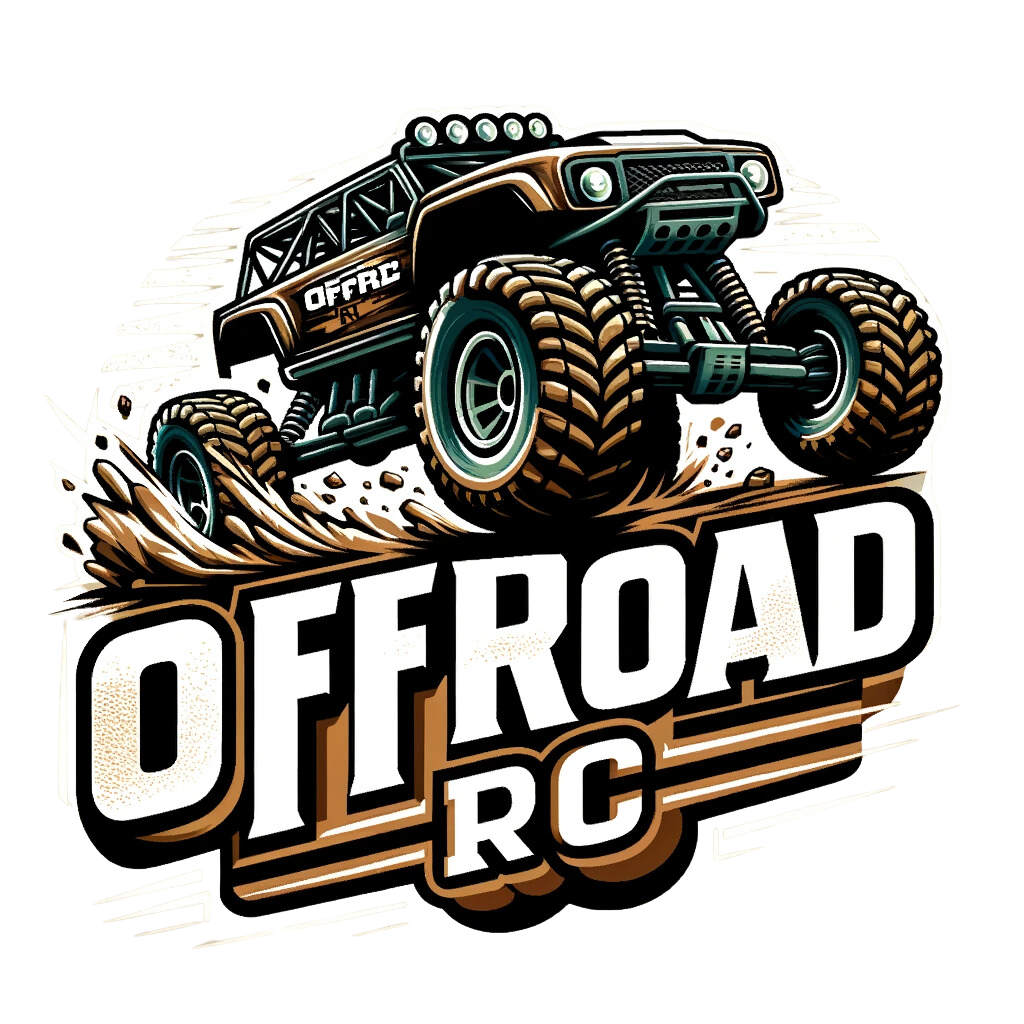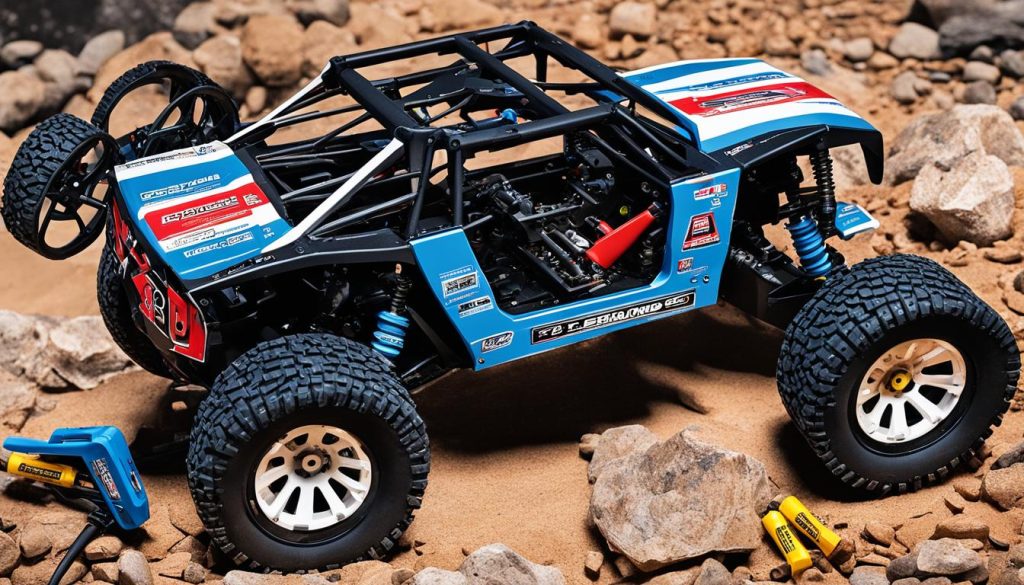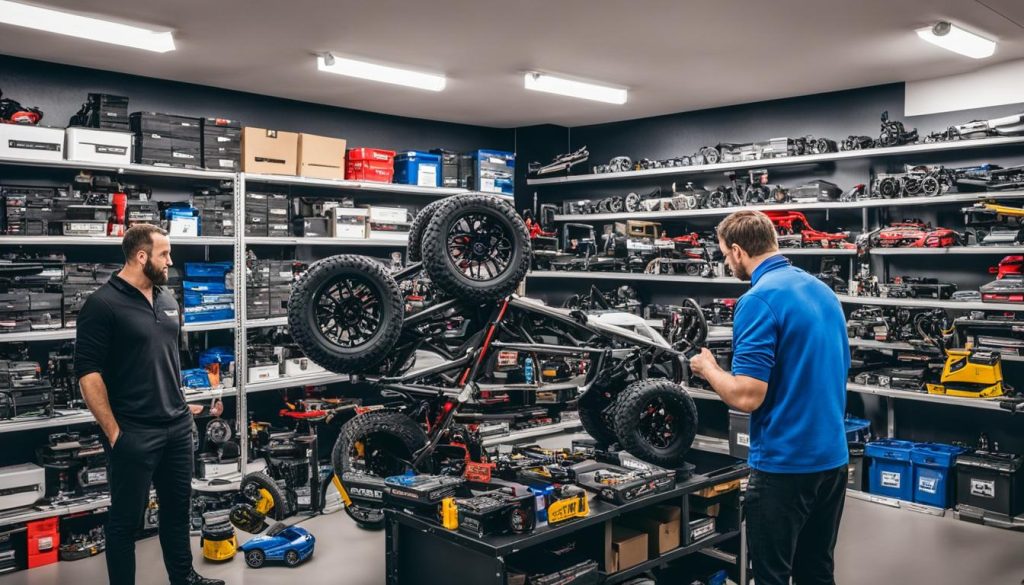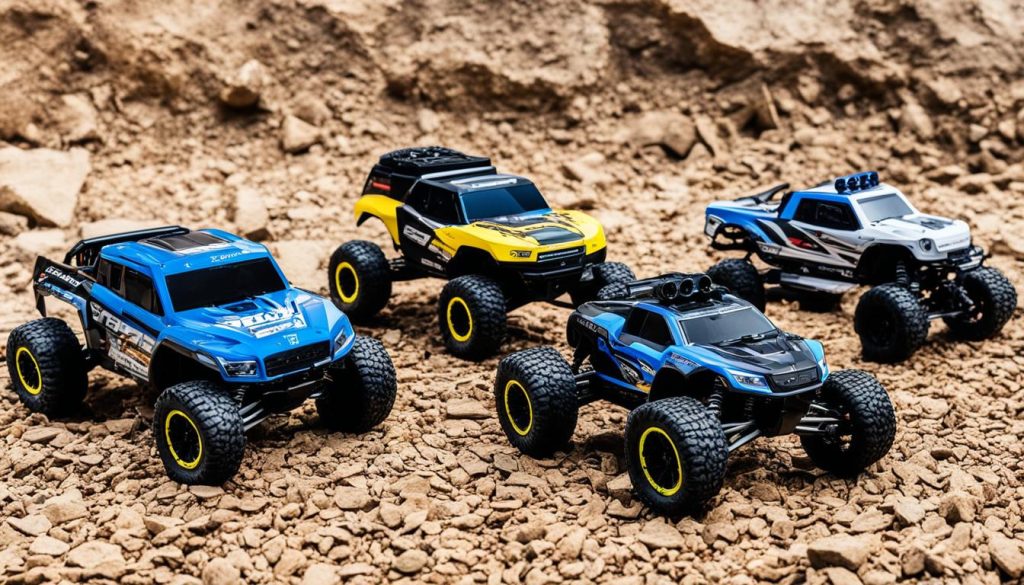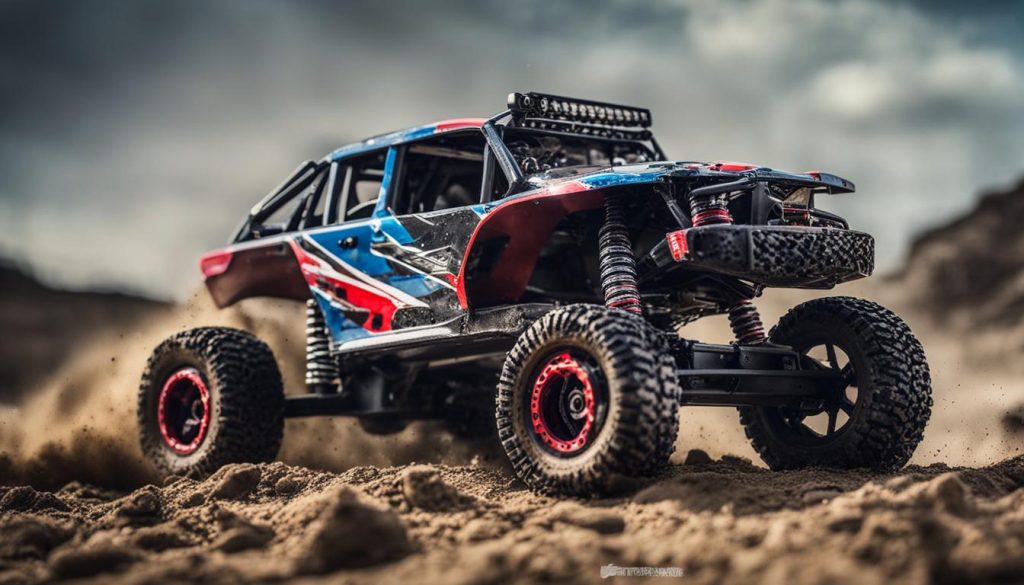When it comes to off-road RC car racing, having the right parts is crucial for optimal performance. Whether you’re a beginner or a seasoned racer, upgrading your off-road RC car with the essential parts can take your racing experience to the next level. From improving traction and suspension to enhancing durability and speed, these necessary components can significantly enhance the performance of your off-road RC car.
Key Takeaways:
- Choosing the right parts is crucial for optimal off-road RC car performance.
- Upgrading tires, suspension, and chassis can improve traction, handling, and durability.
- Accessories like extra tires and CA glue can enhance your racing experience.
- Maintaining quality parts and regularly practicing can improve your skills as a racer.
- Investing in the right brand, power source, and battery pack can impact your off-road RC car’s performance and handling.
Choosing the Right RC Car Brand
The first step in building an off-road RC car is choosing the right brand. With numerous options available in the market, it’s essential to research and select a brand that suits your budget and performance needs. Popular brands in the RC car industry include TRAXXAS, Exceed, HPI, Tamiya, Team Associated, and Losi. Each brand offers its own unique features and price ranges, catering to different levels of expertise and preferences.
TRAXXAS is renowned for its high-performance RC cars and trucks, known for their speed and durability. Exceed offers a wide variety of affordable RC car models, making it an excellent choice for beginners. HPI is a reputable brand known for producing RC cars with exceptional handling and precision. Tamiya is well-known for its attention to detail and scale replicas, catering to hobbyists who enjoy realistic models. Team Associated is a trusted brand among professional racers, producing top-notch RC cars with advanced features. Losi offers a range of off-road RC cars that combine speed, performance, and durability.
To make an informed decision, compare the features, performance, and prices of different models from these brands. Consider your skill level, intended usage, and budget when choosing the right RC car brand for your off-road adventures.
When selecting an RC car brand, it’s important to consider factors such as:
- The type of off-road racing you plan to do
- Your budget and affordability
- Your level of expertise and experience
Remember, the brand you choose will determine the overall quality, performance, and durability of your off-road RC car. Take the time to research and select a brand that aligns with your specific needs and preferences.
Understanding Different Types of RC Cars
When it comes to off-road RC car racing, there is a wide range of options available to suit different terrains and racing styles. Understanding the different types of RC cars will help you make an informed decision about which one is right for you.
Street Cars
Street cars are designed for high-speed racing on paved surfaces. They are built for optimal performance and have low ground clearance to maintain stability. These cars are perfect for racing on smooth, flat tracks. If you enjoy the adrenaline rush of high-speed racing on asphalt, a street car is the ideal choice for you.
Drift Cars
Drift cars are designed specifically for controlled sliding around turns. These cars have a unique setup, including special tires that allow them to slide smoothly through corners. Drift cars are popular for their ability to perform precise maneuvers and showcase impressive driving skills. If you enjoy the challenge of mastering controlled drifts on a track, a drift car is the perfect choice.
Buggies
Buggies are a great option for those who want a blend of off-road and on-road performance. These cars have a lightweight design and long suspension travel, allowing them to handle uneven terrain while maintaining good speed. Buggies are versatile and can adapt to various racing conditions, making them a popular choice among RC enthusiasts.
Truggies
Truggies combine the frame of a buggy with monster truck tires, offering the best of both worlds. These vehicles are designed to tackle rough off-road terrain while maintaining stability and speed. Truggies are an excellent choice for those who enjoy the versatility of a buggy but desire the added capability of larger tires for off-road challenges.
Trucks
Trucks are specially designed for off-road racing and are built to handle rough terrain with ease. They typically feature large, knobby tires and a higher ground clearance, allowing them to navigate through obstacles and rough surfaces. While trucks excel in off-road conditions, they may not perform as well on paved tracks due to their design. If you’re looking for thrilling off-road adventures, a truck is the perfect choice.
Now that you have a better understanding of the different types of RC cars available, you can choose the one that aligns with your racing preferences and the terrain you’ll be tackling. Whether you prefer high-speed racing on paved surfaces, controlled drifts, or off-road adventures, there is a perfect RC car waiting for you.
Electric or Nitro Power?
When it comes to choosing an off-road RC car, one of the first decisions you’ll need to make is whether to go with electric or nitro power. Both options have their advantages and may be better suited to different types of racing and personal preferences.
Advantages of Electric RC Cars
If you’re looking for a more affordable and low-maintenance option, electric RC cars are an excellent choice. Here are some advantages:
- Cheaper: Electric RC cars are generally more affordable upfront compared to nitro RC cars, making them a great option for beginners or those on a budget.
- Cleaner: Unlike nitro RC cars, electric RC cars don’t require fuel to run. This means you won’t have to deal with messy fuel spills or strong odors.
- Less maintenance: Electric RC cars are easier to maintain since they have fewer moving parts. You won’t need to worry about tuning and adjusting the engine like you would with a nitro RC car.
- At-home use: Electric RC cars are quieter and can be safely used indoors or in residential areas without causing disruption or disturbing your neighbors.
Advantages of Nitro RC Cars
On the other hand, if you’re looking for longer run times and a more realistic racing experience, nitro RC cars may be the way to go:
- Longer run times: Nitro RC cars typically have longer run times than electric RC cars due to their larger fuel tanks. This allows for extended racing sessions without needing to recharge batteries.
- Realistic engine sound: Nitro RC cars feature a realistic engine sound that adds to the overall excitement and immersion of the racing experience.
- More power: Nitro RC cars are known for their high-speed capabilities and powerful acceleration. They can provide a thrilling racing experience for enthusiasts who crave speed and performance.
When deciding between electric and nitro power, consider your racing preferences and the environment in which you’ll be using your RC car. Electric RC cars are often the preferred choice for beginners and those who want a more affordable and low-maintenance option. On the other hand, if you’re looking for longer run times and a realistic engine sound, nitro RC cars may be your best bet. Ultimately, the decision depends on your personal preferences and the type of racing experience you’re seeking.
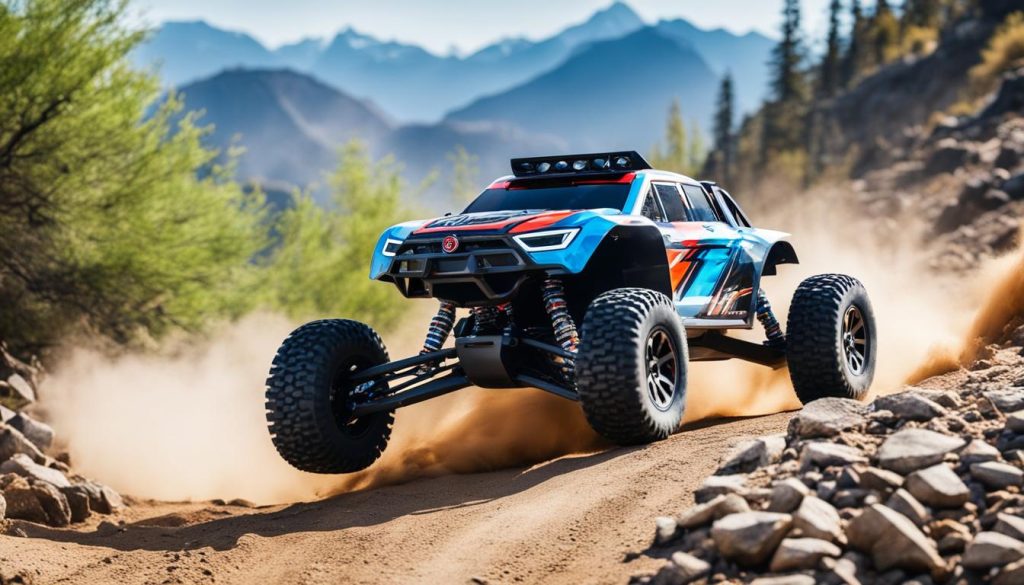
Understanding Electric Motors and ESC
When it comes to the power source for electric RC cars, there are two main options: brushed motors and brushless motors. Each type has its own advantages and considerations to keep in mind.
Let’s start with brushed motors. These motors are generally cheaper and more affordable compared to their brushless counterparts. They have been widely used in RC cars for many years. Brushed motors are reliable and easy to maintain, making them a popular choice for beginners or those on a budget.
However, brushed motors are less efficient and less powerful compared to brushless motors. They produce more heat, which can affect overall performance and potentially reduce their lifespan. If you’re looking for maximum speed and acceleration, a brushed motor might not deliver the level of performance you desire.
On the other hand, brushless motors are known for their efficiency, power, and durability. They utilize advanced technology to deliver better acceleration, higher top speeds, and improved overall performance. Brushless motors are a favorite among experienced RC car enthusiasts and competitive racers.
Although brushless motors may have a higher upfront cost, their superior performance and longevity make them a worthy investment. With reduced maintenance requirements and increased power output, brushless motors offer a significant advantage when it comes to high-speed off-road racing.
Both brushed and brushless motors require an ESC (Electronic Speed Controller) to control the motor’s speed. The ESC acts as the intermediary between the motor and the radio control system, allowing you to adjust the speed and acceleration of your RC car.
Whether you choose a brushed or brushless motor, it’s essential to consider your budget, performance expectations, and skill level. Understanding the difference between these motors will help you make an informed decision and maximize the performance of your off-road RC car.
Upgrading to Brushless Motors
If you are looking to take your RC car to the next level, upgrading to a brushless motor is a great choice. Brushless motors offer superior performance and efficiency compared to their brushed counterparts. When upgrading, it’s important to consider the right brand, motor rating, and other factors to ensure the best possible upgrade for your RC car.
Brands of Brushless Motors
There are several reputable brands that offer top-quality brushless motors for RC cars. Three popular choices are:
| Brand | Description |
|---|---|
| Hobbytron | Known for their wide range of brushless motors and accessories, Hobbytron is a trusted brand in the RC car industry. |
| Mamba Max | Mamba Max is known for their high-performance brushless motors, offering exceptional speed and power. |
| Sidewinder | Sidewinder is a reliable and popular brand, producing brushless motors that deliver excellent performance and durability. |
When choosing a brand, consider factors such as reliability, performance, and customer reviews to make an informed decision.
Motor Rating: Speed and Type
When selecting a brushless motor, the motor rating plays a crucial role in determining its performance. The motor rating is indicated by two numbers: the kv rating and the t rating.
The kv rating represents the number of rotations per minute per volt and indicates the speed of the motor. Higher kv ratings result in faster speeds, while lower kv ratings offer more torque and better off-road performance.
The t rating represents the type of motor, with lower numbers better suited for off-road driving and higher numbers for on-road driving. A lower t rating indicates a motor that provides more torque and better low-speed control, making it ideal for off-road scenarios.
Consider your driving style and preferences when choosing the right motor rating for your RC car.
By upgrading to a brushless motor, you can greatly enhance the speed, power, and overall performance of your RC car. Research different brands, carefully consider motor ratings, and choose the upgrade that best suits your needs and driving style.
Understanding Electric Car Layout
When it comes to off-road RC cars, understanding the electric car layout is essential for proper maintenance and upgrades. These cars follow a typical layout that consists of various components, each playing a crucial role in their performance and durability.
Chassis
The chassis is the main structure of the RC car, serving as the foundation for all other components. It provides stability, strength, and support to the entire vehicle.
Suspension System
The suspension system of an off-road RC car is responsible for controlling the movement of the wheels. It absorbs shocks, enhances traction, and ensures a smooth ride over rough terrains.
Drive Train
The drive train is responsible for transferring power from the motor to the wheels, allowing the car to move forward or backward. It consists of various components such as gears, driveshafts, and differentials.
Motor
The motor is the heart of an electric RC car. It converts electrical energy into mechanical energy, propelling the car forward. There are different types of motors available, such as brushed and brushless motors, each with its own advantages and performance characteristics.
Electronics
The electronics in an RC car control various functions, including steering, throttle, and braking. The electronic speed controller (ESC) regulates the motor’s speed, ensuring smooth and precise control over the vehicle.
To visualize the different parts of an off-road RC car, refer to the diagram below:
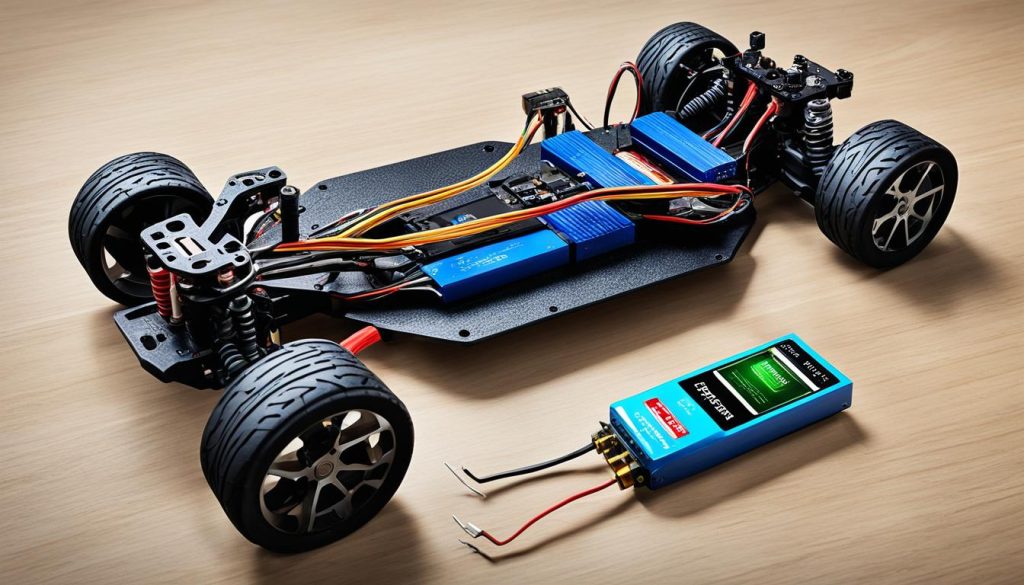
Understanding the layout of an electric RC car allows you to make informed decisions when it comes to maintenance, upgrades, and customizations. By familiarizing yourself with each component and its role, you can optimize the performance of your off-road RC car and ensure its longevity.
Choosing the Right Battery Pack
When it comes to powering your off-road RC car, selecting the right battery pack is crucial. Consider your preferences and budget to make an informed decision. Two popular options are LiPo (Lithium Polymer) and Ni-Mh (Nickel-Metal Hydride) batteries, each with its own advantages and considerations.
“The right battery pack can greatly impact the performance and runtime of your off-road RC car. Choose wisely!”
LiPo Battery
LiPo batteries are known for their superior performance and power delivery. They offer longer run times, making them ideal for extended racing sessions. Additionally, LiPo batteries provide a higher voltage output, resulting in greater speed and acceleration.
However, it’s important to note that LiPo batteries require special care and attention. They are more sensitive and vulnerable to damage if mishandled. When charging LiPo batteries, be sure to use a compatible charger and always follow the manufacturer’s instructions to avoid any safety risks.
Ni-Mh Battery
Ni-Mh batteries, on the other hand, are a more cost-effective and safer option. They have a shorter lifespan compared to LiPo batteries, but they are less prone to damage and easier to maintain. Ni-Mh batteries are also less sensitive when it comes to charging and handling.
If you’re just getting started in the world of off-road RC cars or prefer a more user-friendly option, Ni-Mh batteries may be the better choice for you.
Consider Battery Capacity and Rating
When selecting a battery pack, it’s important to consider the capacity (mAh) and the rating (C). The capacity indicates the amount of charge the battery can hold, while the rating represents the battery’s discharge rate. A higher capacity allows for longer run times, while a higher rating provides greater power output.
Here’s a breakdown of the key factors to consider:
| Battery Type | Advantages | Considerations |
|---|---|---|
| LiPo | Longer run times Increased power delivery Lightweight |
Requires careful handling and charging More expensive |
| Ni-Mh | Cost-effective option Safer and easier to manage Wider availability |
Shorter lifespan Lower power output |
When it comes to battery capacity, you’ll want to choose a pack that offers sufficient runtime for your off-road adventures. Consider the duration of your races and the available charging facilities to optimize your racing experience.
As for the battery rating, higher values provide more power output but may require a compatible motor and ESC (Electronic Speed Controller). Make sure your RC car’s components can handle the rating of your chosen battery pack to avoid any compatibility issues.
By carefully considering the pros and cons of LiPo and Ni-Mh batteries, as well as the capacity and rating, you can select the ideal battery pack for your off-road RC car.
Recommended Accessories and Final Tips
To enhance your off-road RC car experience, consider investing in additional accessories that can improve performance, convenience, and maintenance. Here are some recommended accessories and final tips to optimize your RC car’s performance and ensure its longevity.
1. RC Car Accessories
Investing in the right RC car accessories can elevate your off-road racing experience. Some essential accessories to consider are:
- Extra Tires: Different terrains require different tire types. Investing in a set of extra tires with varying treads can provide better traction and stability, maximizing your car’s performance on various surfaces.
- CA Glue: Quick repairs are essential in off-road racing. CA glue (cyanoacrylate adhesive) is ideal for fixing minor damages like loose parts or broken components. Its fast-drying formula ensures minimal downtime during races.
- Body Clips and Pins: These small accessories secure the RC car’s body and prevent it from coming loose during intense races. It’s always a good idea to have extra body clips and pins on hand in case any get lost or damaged.
- Shock Covers: Off-road racing can be rough on your suspension system. Shock covers protect your shocks from dust, debris, and moisture, extending their lifespan and maintaining consistent performance.
- Tools and Toolkits: A proper set of RC car tools, such as screwdrivers, pliers, and hex wrenches, will come in handy for routine maintenance, repairs, and adjustments.
2. Investing in Quality Parts
Investing in quality parts for your RC car is essential for optimal performance and durability. Choosing reputable brands like TRAXXAS, HPI, or Tamiya ensures that you are getting reliable and well-built components. Quality parts not only enhance your car’s performance but also reduce the risk of frequent breakdowns, saving you time and money in the long run.
3. Regular Maintenance Tips
To keep your RC car in top condition, regular maintenance is crucial. Here are some maintenance tips to follow:
- Clean your RC car after each race to remove dirt, debris, and moisture that can affect its performance and cause premature wear. Use a soft brush and compressed air to clean hard-to-reach areas.
- Inspect and tighten screws, nuts, and bolts regularly to ensure everything is secure. Loose components can lead to poor performance and potential damage.
- Grease and lubricate moving parts, such as gears and axles, to reduce friction and maintain smooth operation.
- Check and balance the tire pressure to optimize traction and stability. Inflate or deflate the tires based on the terrain you’ll be racing on.
- Keep track of any setup changes and track conditions that affect your car’s performance. Maintaining a record allows you to fine-tune your RC car for future races.
Remember, regular maintenance not only extends the lifespan of your RC car but also ensures consistent performance on the track.
4. Seek Advice from Experienced Racers
Improving your skills as an off-road RC car racer can be a continuous learning process. Seek advice from experienced racers who can offer valuable insights, tips, and techniques. Participating in local RC car clubs or online groups can connect you with a community of knowledgeable enthusiasts who are passionate about the hobby.
Now that you have an overview of recommended accessories and final tips, you can elevate your off-road RC car experience and enjoy thrilling races with improved performance, stability, and maintenance.
Conclusion
Building and upgrading an off-road RC car requires careful consideration of the essential parts. By following this comprehensive off-road RC car parts guide, you can make informed decisions and enhance your RC car’s performance and handling.
Firstly, when choosing a brand, consider options such as TRAXXAS, Exceed, HPI, Tamiya, Team Associated, and Losi. Research their features and price ranges to find the one that suits your budget and performance needs.
Understanding the different types of RC cars, including street cars, drift cars, buggies, truggies, and trucks, will help you choose the right one for your racing style. Remember that each type is designed for specific surfaces and offers different capabilities.
Choosing between electric or nitro power depends on your preferences and the type of racing you plan to do. Electric RC cars are generally cheaper and cleaner, while nitro RC cars offer longer run times and a realistic engine sound.
When it comes to motors, brushless motors are more efficient, powerful, and durable compared to brushed motors. Upgrading to a brushless motor is a popular choice for enhanced acceleration and performance.
Other important considerations include understanding the layout of an electric RC car, choosing the right battery pack (such as LiPo or Ni-Mh), and investing in quality parts. Regular maintenance and keeping a record of setup changes and track conditions will also contribute to the longevity and performance of your RC car.
Remember, building and upgrading an off-road RC car is a journey that requires patience and careful decision-making. By following this guide and considering your preferences and racing style, you can enjoy the thrill of high-speed racing and maximize your off-road RC car experience.
FAQ
What are the essential parts for off-road RC cars?
The essential parts for off-road RC cars include tires, suspension, chassis, motor, electronics, and battery pack.
Which brands of RC cars should I consider?
Popular brands in the RC car industry include TRAXXAS, Exceed, HPI, Tamiya, Team Associated, and Losi.
What types of RC cars are suitable for off-road racing?
There are various types of RC cars suited for off-road racing, including street cars, drift cars, buggies, truggies, and trucks.
Should I choose an electric or nitro power RC car?
The choice between electric and nitro power depends on your preferences and the type of racing you plan to do. Electric cars are generally cheaper and require less maintenance, while nitro cars offer longer run times and a realistic engine sound.
What is the difference between brushed and brushless motors?
Brushed motors are cheaper and less efficient, while brushless motors are more powerful and durable. Brushless motors offer better acceleration and overall performance.
Can I upgrade my RC car to a brushless motor?
Yes, you can upgrade your RC car to a brushless motor. Some popular brands for brushless motors include Hobbytron, Mamba Max, and Sidewinder.
What are the different parts of an off-road RC car?
An off-road RC car consists of various components, including the chassis, suspension system, drive train, motor, and electronics.
How do I choose the right battery pack for my RC car?
When selecting a battery pack, consider the capacity (mAh) and the rating (c) to ensure a proper fit and performance for your off-road RC car.
What are some recommended accessories for off-road RC cars?
Some recommended accessories for off-road RC cars include extra tires, CA glue for quick repairs, and investing in quality parts. Regular maintenance is also important for optimal performance and longevity.
How can I enhance my off-road RC car experience?
To enhance your off-road RC car experience, practice regularly, seek advice from experienced racers, and keep a record of setup changes and track conditions for future reference.
